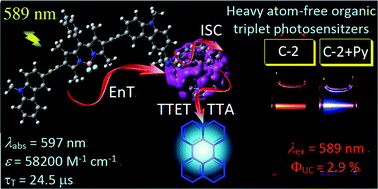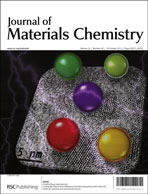The synthesis of visible light-harvesting C60-bodipy dyads (bodipy = boron-dipyrromethene), and the study of the photophysical properties and the application of dyads as heavy-atom free organic triplet photosensitizers for triplet–triplet annihilation (TTA) based upconversion, are reported. By attaching carbazole units to the π-core of the bodipy chromophore via an ethynyl linker, the absorption wavelength of the antenna in the dyads is readily tuned from 504 nm for the unsubstituted bodipy, to 538 nm (one carbazole unit, ε = 61 800 M−1 cm−1) and 597 nm (two carbazole units, ε = 58 200 M−1 cm−1). Upon photoexcitation at 538 nm (dyad C-1) or 597 nm (dyad C-2), intramolecular energy transfer from the antenna to the C60 unit occurs, and as a result, the singlet excited state of the C60 unit is populated. Subsequently, with the intrinsic intersystem crossing (ISC) of C60, the triplet excited state of the C60 unit is produced (τT up to 24.5 μs). Thus, without the need for any heavy atoms, the triplet excited state of the dyads was populated upon visible light excitation. The population of the C60-localized triplet excited state of the dyads was confirmed by nanosecond time-resolved transient difference absorption spectra and spin density analysis. The dyads were used as triplet photosensitizers for TTA upconversion and upconversion quantum yields of up to 2.9% were observed.

You have access to this article
 Please wait while we load your content...
Something went wrong. Try again?
Please wait while we load your content...
Something went wrong. Try again?


 Please wait while we load your content...
Please wait while we load your content...